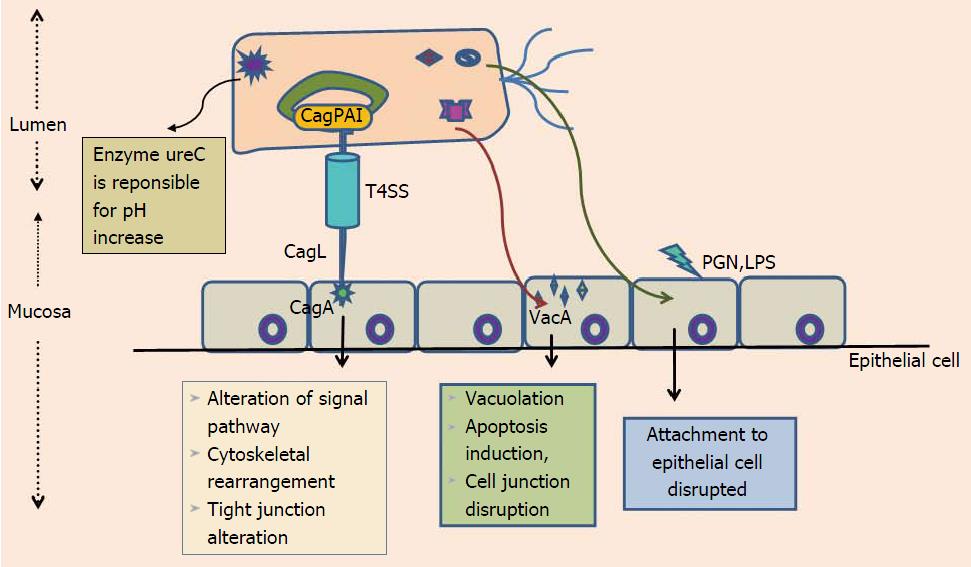Copyright
©The Author(s) 2016.
World J Gastrointest Oncol. Feb 15, 2016; 8(2): 147-158
Published online Feb 15, 2016. doi: 10.4251/wjgo.v8.i2.147
Published online Feb 15, 2016. doi: 10.4251/wjgo.v8.i2.147
Figure 1 Interaction between Helicobaceter pylori type IV secretion system and virulence determinants such as CagA, CagL, lipopolysaccharides, pepetidoglycan and vacuolating cytotoxin gene, with mucosal epithelial cells, resulting in alteration of signal pathways, cell polarity disruption and vaccuolation, which ultimately leads to death.
T4SS: Type IV secretion system; LPS: Lipopolysaccharides; PGN: Pepetidoglycan; VacA: Vacuolating cytotoxin; CagPAI: Cag pathogenicity island.
Figure 2 Combination of host, bacterial and environmental factors, which act in a synergetic way, resulting in development of precancerous cascade that ultimately leads to development of gastric cancer.
ZO-1: Zonula occludens 1; CagPAI: Cag pathogenicity island; JAM: Junctional adhesion molecule; VacA: Vacuolating cytotoxin; Cytc: Cytochrome.
Figure 3 Schematic representation of multiple pathways of Helicobacter pylori pathogenesis involved type IV secretion system and internalization of virulence determinants like CagA and oncoproteins; CagA-phosphorylation dependent and CagA-phosphorylation independent pathways leads to cytoskeletal reorganization, increase proinflammatory and mitogenic gene expression.
Another major virulent factor, VacA is responsible for alteration of junction and cell polarity by binding with tight junction molecules such as E-cadherin, ZO. VacA also causes mitochondrial membranes depolarization, Cytc release from mitochondria to cytosol and caspase-3 activation followed by cell apoptosis. T4SS: Type IV secretion system; VacA: Vacuolating cytotoxin; ZO: Zonaoccludans; Cytc: Cytochrome; H. pylori: Helicobacter pylori.
Figure 4 Representation of Helicobaceter pylori major virulence factor, vacuolating cytotoxin containing three domain 1: signal sequence(S) 2: middle region (m) 3: recently identified intermediate region (i) s, m and i region are further stratified into the subtypes s1, s2, m1, m2 and i1, i2 respectively.
TLR4: Toll like receptor 4; T4SS: Type IV secretion system; VacA: Vacuolating cytotoxin; CagPAI: Cag pathogenicity island; GC: Gastric cancer; ROS: Reactive oxygen species.
Figure 5 Vacuolating cytotoxin of Helicobacter pylori may have any combination of signal sequence and mid region with different virulence activities as stated above.
Vac: Vacuolating cytotoxin.
- Citation: Khatoon J, Rai RP, Prasad KN. Role of Helicobacter pylori in gastric cancer: Updates. World J Gastrointest Oncol 2016; 8(2): 147-158
- URL: https://www.wjgnet.com/1948-5204/full/v8/i2/147.htm
- DOI: https://dx.doi.org/10.4251/wjgo.v8.i2.147













